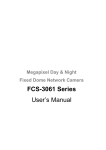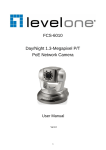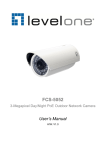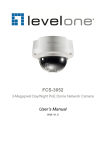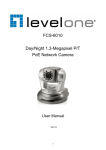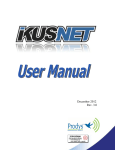Download LevelOne FCS-1122
Transcript
LevelOne User Manual FCS-1122 Megapixel PoE Network Camera Ver 1.0 Table of Contents Before You Use This Product ..................................................................... 5 Package Contents ................................................................................... 5 Product Overview ................................................................................... 6 Device Appearance Description ..................................................................... 7 LED Behavior ................................................................................................................. 8 Extension I/O Terminal Block .......................................................................................... 9 Hardware Reset ............................................................................................................ 10 System Requirements ...................................................................................................11 Camera Connection ...................................................................................................... 12 Check Network Settings ............................................................................................... 21 Add Password to prevent Unauthorized Access ........................................................... 21 Authentication ............................................................................................................... 22 Installing plug-in ............................................................................................................ 22 Camera/Video/Audio..................................................................................................... 26 Camera ...................................................................................... 26 Video ........................................................................................ 28 Audio ........................................................................................ 31 Multicast ................................................................................... 32 Network ........................................................................................................................ 33 IP Setting .................................................................................. 33 UPnP ......................................................................................... 34 DDNS (dynamic domain name service) ......................................... 34 Easy Link................................................................................... 36 HTTP/HTTPS .............................................................................. 36 Event 38 Motion Detection ........................................................................ 38 Notification setting ..................................................................... 39 Scheduled Event ........................................................................ 42 DI/DO ....................................................................................... 43 System.......................................................................................................................... 44 System Log ............................................................................... 44 Date & Time Settings .................................................................. 44 Device Information ..................................................................... 46 Maintenance ................................................................................................................. 47 User Management ...................................................................... 47 IP Filter ..................................................................................... 48 Firmware Upgrade ...................................................................... 48 Configuration ............................................................................. 48 Reset to default .......................................................................... 49 Reboot ...................................................................................... 49 Default Settings IP Address DHCP Username admin Password admin General Public License This product incorporates open source code into the software and therefore falls under the guidelines governed by the General Public License (GPL) agreement. Adhering to the GPL requirements, the open source code and open source license for the source code are available for free download at http://global.level1.com. If you would like a copy of the GPL or other open source code in this software on a physical CD medium, LevelOne (Digital Data Communications) offers to mail this CD to you upon request, for a price of US$9.99 plus the cost of shipping. Before You Use This Product In many countries, there are laws prohibiting or restricting the use of surveillance devices. This Network Camera is a high-performance, web-ready camera which can be part of a flexible surveillance system. It is the user’s responsibility to ensure that the operation of this camera is legal before installing this unit for its intended use. Upon opening the product’s package, verify that all the accessories listed on the “Package Contents” are included. Before installing the Network Camera, read the warnings in the “Quick Installation Guide” to avoid misuse. When installing the Network Camera, carefully read and follow the instructions in the “Installation” chapters to avoid damages due to faulty assembly or installation. Package Contents Network Camera CS mount Lens Camera Stand Power Adapter Quick Installation Guide CD Manual/utility Product Overview The LevelOne FCS-1122 IP camera offers reliable and excellent video quality solution for 24-hour surveillance application. The camera offers highly efficient H.264 video compression, which reduces bandwidth and storage requirements without compromising image quality. M-JPEG and MPEG-4 are also supported for flexibility. Users can view live, motion image from anywhere by web browser or mobile phone via Internet or 3G network respectively. With the megapixel progressive sensor this camera delivers extremely clear and detailed images that CCTV cameras cannot offer. FCS-1122 receives power through the same cable as for data transmission (PoE). This makes installation easy because there is no external power supply needed. For easy setup, “Easy Installation Wizard” makes the configuration simple even for users without IT background. The LevelOne IP camera simplifies the hardware and software installation by flexible design and multiple applications. In other words, the FCS-1122 is not only for normal home security but also suitable for professional surveillance demand such as bank, office building, and factory applications. 6 Device Appearance Description Light Sensor Status LED Built-in Microphone Power Connector Ethernet RJ45 10/100 Socket (DC12V In) Reset Button Extension I/O Terminal Block Microphone/Line In Audio Out Auto Iris Connector 7 LED Behavior Function LED Behavior Status Description Remark Hardware Front Left failure (Green) 1. Restoring Status settings Steady On 2. Normal Front Left (Green) Operation The LED can be Status Unlighted 1. Power Off configured 2. Power On to be till System unlighted setup during normal operation Status Link Blinking While F/W Front Left upgrading (Green) Blinking while Rear Left network (Orange) connection in progress Link No connection Unlighted Rear Left (Orange) Power Power Normal Steady On Unlighted Rear Right Operation (Green) Power off Rear Right (Green) 8 Extension I/O Terminal Block The Network Camera provides an extension I/O terminal block which is used to connect external input/output devices. The pin definitions are listed as below. Pin Function 1 Power +4.5V 2 Digital Output 3 Digital Input 4 Ground 5 RS-485 - 6 RS-485 + DI/DO Diagram 9 Hardware Reset Reset Button The Reset Button can be used to reboot the camera or restore it to factory default settings. If the camera experiences a problem, rebooting the camera may correct the problem. If the problem remains, please restore the camera to factory default settings and reinstall the software. To Reboot - Press and hold the Reset Button for one second using a paper clip or thin object. Wait for the camera to reboot. To Restore – Press and hold the Reset Button for ten seconds until the LED light turns off. When successful restored, the LED will be green during normal operation. 10 Installation System Requirements Operating System: Microsoft Windows XP Home Edition SP2 Microsoft Windows XP Professional SP2 Computer: IBM PC/AT Compatible CPU: Pentium 3GHz or faster Memory: 1024 MB or more Monitor: 1024 x 768 pixels or more, 24-bit True color or better Network Interface: 10/100Mbps Network interface card must be installed Web Browser: Microsoft Internet Explorer 6.0 SP2 CD-ROM Drive: It is necessary to read the operating instructions in the provided CD-ROM. Adobe Reader: It is necessary to read the operating instructions in the provided CD-ROM. Audio function will not be working if a sound card is uninstalled on PC. Audio may be interrupted depending on the network environment. 11 Camera Connection Basic Connection (Without PoE) 1.1 If you have external devices such as sensors and alarms, please make connections with extension I/O terminal block. 1.2 Connect the camera to a switch via Ethernet cable. 1.3 Connect the supplied power cable from the camera to the power outlet. Please check your product package contains all the accessories listed in the foregoing Package Contents. Depending on the user’s application, an Ethernet cable may be needed. The Ethernet cable should meet the specs of UTP Category 5 and not exceed 100 meters in length. Upon powering up, the power LED will become lighted first and then the device will go through booting process. The link LED will be steady amber for getting IP address. After getting IP Address, the link LED will blink orange while network connection is processing. 12 Power over Ethernet (PoE) Connection 1.1. When connecting to PoE-enabled switch The camera is PoE compliant and please connects the camera to a PoE-enabled switch via single Ethernet cable. 1.2. When connecting to a non-PoE switch Please connect the camera to a non-PoE switch via PoE Injector (optional). 13 Software installation In this manual, "User" refers to whoever has access to the Network Camera, and "Administrator" refers to the person who can configure the Network Camera and grant user access to the camera. After hardware connection checking, the users can run the Installation Wizard program included in the product CDROM to automatically search for the Network Camera in the Intranet. There may be many Network Cameras in the local network. Users can differentiate the Network Cameras with the serial number. The serial number is printed on the labels on the carton and the bottom of the Network Camera body. 1. Insert the Installation CD into the CD-ROM driver. Click install and shows the welcome screen. Follow the steps to install the Installation wizard on user’s computer. 14 15 16 2. Do not check the box if user would like to check the hardware installation settings, Otherwise click “Skip the hardware installation” to skip the hardware connection checking, the program will automatically search for the Network Camera in the Intranet. Click “Start” to continue. 3. Select the Network Camera from the survey list and enter the user name and password. The user name and password are assigned as “admin/admin”. 17 4. Setting the Network Camera IP address User can either select simple mode or professional mode for network camera IP setting. If simple mode is selected, the easy configuration program will set up the connection automatically. If professional mode is selected, the user will need to configure the IP manually, The DHCP setting is recommended. If user wants to set IP address manually, please refer to the product user manual. 18 19 5. After finish setting, the connection successful or fail showed. If connection failed, user can either try again or quit the installation. User can either select "Start Web GUI" to continue or click “X” on the top right of the screen to finish the installation. Once installation is completed, the Administrator should proceed to the next section "Access to the Network Camera" for necessary checks and configurations. 20 Access to the Network Camera Check Network Settings The Network Camera can be connected either before or immediately after software installation onto the Local Area Network. The Administrator should complete the network settings on the configuration page, including the correct subnet mask and IP address of gateway and DNS. Ask your network administrator or Internet service provider for the detail information. Add Password to prevent Unauthorized Access The Administrator should immediately implement a new password as a matter of prudent security practice. The user name and password for the Administrator are assigned as “admin/password”. Once the Administrator’s password is saved, the Network Camera will ask for the user’s name and password before each access. The Administrator can set up a maximum of ten (10) user accounts. Each user can access the Network Camera except to perform system configuration. Once the password is changed, the browser will display an authentication window to ask for the new password. Once the password is set, there is no provision to recover the Administrator’s password. The only option is to restore to the original factory default settings. 21 Authentication After opening the Web browser and typing in the URL of the Network Camera, a dialogue window pops up to request a username and password. The user name and password for the Administrator are assigned as “admin/admin”. Installing plug-in For the initial access to the Network Camera in Windows, the web browser may prompt for permission to install a new plug-in for the Network Camera on the Internet Explorer. Permission request depends on the Internet security settings of the user’s PC or notebook. If the highest security level is set, the computer may prohibit any installation and execution attempt. This plug-in has been registered for certificate and is used to display the video in to proceed. If the web browser does not the browser. Users may click on allow the user to continue to install, check the Internet security option and lower the security levels or contact your IT or networking supervisor for help. 22 Live View Live View is the default page that opens when accessing the Network Camera. Live video is displayed directly in the browser window. Stream1/Stream2 Channels The network camera offers simultaneous dual stream for optimized quality and bandwidth. Go to Configuration → Camera/Video/Audio → Video to configure the codec compression and video resolution or refer to the Video configuration page.. 23 HTTP/TCP/UDP protocol HTTP – This unicast method can be used to traverse firewalls. Firewalls are commonly configured to allow the HTTP protocol, thus allowing RTP to be tunneled. TCP - This protocol guarantees the complete delivery of streaming data and provides better video quality. The downside of using this protocol is that the quality of its real-time effect is less than that of the UDP protocol. UDP - This protocol allows for more real-time audio and video streams. However, network packets may be lost due to network burst traffic and images may be broken. Activate UDP connection time-sensitive responses are more important than video quality. / Recording on/off: shows the status of recording video / MIC on /off: shows the status of MIC volume. / Speaker on/off: Displays the status of the Speaker Brightness - Drag the slider bar to adjust the image brightness level. Mic volume - Drag the slider bar to adjust the microphone volume. Speaker volume - The built-in speaker will play sound from an audio clip from the computer microphone when it is enabled. For more Audio settings, please refer to the Audio configuration page. Play or Stop: Click this button to play or stop the video. Recording: Click this button to record video to your computer. Snapshot: Click this button to capture and save still images. 24 Digital Zoom: Click this button to enable the zoom operation. Mirror: horizontally reflect the display of the live video. Flip: vertically reflect the display of the live video. Real Size: click this button to view the object in real size. Press this button again to switch back to normal mode. Full Screen: Click this button to switch to full screen mode. Press “Esc” key to switch back to normal mode. Mute: Turn off the sound Talk: To communicate through the camera using the computer MIC. Set Default: Reset to default settings. NOTE: The <Video Control Panel> function has no effect on the recorded video. Whatever changes made to the <Video Control Panel> will not be applied to the recorded video. 25 Configuration Click <Configuration> on the main page to change the camera settings pages. Camera/Video/Audio Camera Camera Setting Brightness: Drag the slider bar to adjust the image brightness level ranging from -5 to +5. Contrast: Drag the slider bar to adjust the image contrast level ranging from -5 to +5. Sharpness: Drag the slider bar to adjust the image sharpness level ranging from -5 to +5. Saturation: Drag the slider bar to adjust the image saturation level ranging from -5 to +5. 26 Exposure Control: Select exposure level automatically or manually. Auto Iris: Enable Auto Iris Mirror and Flip Mirror: Enable to horizontally reflect the display of the live video. Flip: Enable to vertically reflect the display of the live video. Flicker-Free: While flicker-free technology eliminates the problem of flicker, it can cause slight judder on fast moving images or blurring problems; fast scrolling text for example may blur. True Day & Night Auto: The Network Camera automatically removes the filter by judging the level of ambient light. Manual: the Network Camera switches off the IR cut filter at all times for the sensor to accept the infrared light, thus helps improve low light sensitivity. Color Effect: Select to display color or black and white video streams. Click Apply or Reset to take effect. . 27 Video You can set up two separate streams for the Network Camera for different viewing devices. Stream 1 & Stream 2 Video Codec: The Network Camera offers three choices of video codec standards for real-time viewing: H.264, MPEG-4 and MJPEG. Video Resolution: select from the drop down list to choose the best resolution that fit your need. Frame Rate: Select from the drop down list of the frame rate, which ranges from 2 to 30 fps when H.264 or MJPEG is selected. Only 3 to 15 fps can be chosen when MPEG-4 is selected. Set the frame rate higher for a smoother video quality. 28 Video quality and bit rate: User can either choose “quality” or “bitrate” to control the video quality with video codec at H.264 or MPEG4. Only “quality” can be chosen when video codec at MJPEG is selected. Set the bitrate higher for a better video quality. However, high bitrate may cost high network bandwidth resources. Quick setting: Optimize setting for mobile stremaing. Click Apply or Reset to take effect. Video Overlay: Check to enable the timestamp function and select display position from the drop-down list if user wants date and time to be shown on the screen of the live video. User may also enable and enter the video description in text box; and select display position from the drop-down list if user wants to make a note about the network camera. Click Apply or Reset to take effect. NOTE: The video overlay only takes effect in stream 1. 29 To utilize RTSP authentication, the user must first set a password for the camera. RTSP (Real-Time Streaming Protocol) controls the delivery of streaming media. By default the port number is set to 554. Authentication: Depending on the network security requirements, the camera provides two types of security settings for streaming via RTSP protocol: NONE and DIGEST. If DIGEST authentication is selected, user credentials are encrypted using MD5 algorithm, thus providing better protection against unauthorized access. Click Apply or Reset to take effect. Save file folder Recording folder path: The destination for saving the recording video files. Click browse to specify the saving path. Snapshot folder path: The destination for saving the snapshot files. Click browse to 30 specify the saving path. Click Apply or Reset to take effect. Audio The administrator can set up two separate streams for the camera for different viewing devices. The administrator can enable or disable the audio function on either stream. If audio enable is selected, select the Audio codec from the drop-down menu. Click Apply or Reset to take effect. Mic Type: Choose mic input, Built-in or Line in. 31 Camera Speaker: If the speaker is enabled, select the volume from the drop-down menu. Echo Cancellation Enabled: Enable to avoid an echo. Click Apply or Reset to take effect. Multicast Multicast addressing is a network technology for the delivery of information to a group of destinations simultaneously using the most efficient strategy to deliver the messages over each link of the network only once, creating copies only when the links to the multiple destinations split. You can either enable or disable the stream1or stream 2 for the Network Camera. The default value for multicast address and port are 234.1.2.3 and 10000. Use different port number for different stream. Use default value is recommended if you are not sure how to setting. Click Apply or Reset to take effect. 32 Network IP Setting IP Setting: This section explains how to configure wired network connection for the Network Camera. There are several ways to setup the Network Camera over the Internet. The first way is to obtain an available dynamic IP address assigned by a DHCP server. The second way is to utilize a static IP. The third way is to use PPPoE. DHCP: Get IP address automatically. Select this option to obtain an available dynamic IP address assigned by a DHCP server each time the camera is connected 33 to the LAN. Static IP: Select this option to manually assign a static IP address to the Network Camera. Enter the static IP address, Subnet mask, Default Gateway, Primary and Secondary DNS provided by your ISP. PPPoE (Point-to-point over Ethernet): Choose this connection type if you are connected to the Internet via a DSL Line. Note that to utilize this feature, it requires an account provided by your ISP. Enter the user name and password provided by your ISP. Click Apply or Reset to take effect. UPnP Only UPnP discovery supported. Enable this function to allow the user to search for devices of interest on the network. Enter the UPnP name as you wish to show on the intranet. Click Apply or Reset to take effect. DDNS (dynamic domain name service) DynDNS: Enable the DDNS service allows your Network Camera, especially when assigned with a dynamic IP address, to have a fixed host and domain name. Note that before utilizing this function; please apply a dynamic domain account first. Enter the username, password and hostname when enabled the DDNS. 34 Click Apply or Reset to take effect. TZO: TZO is one kind of the DDNS providers. User can refer to the TZO.com: visit http://www.tzo.com/ to apply a dynamic domain account when selecting this DDNS provider. Enter the e-mail address, password and domain name when enabled the TZO. Click Apply or Reset to take effect. 35 Easy Link Easy Link: the IP camera had bundle with free Level1DNSTM service that allows user to remote access the IP camera via internet. The default domain name is MAC address, you can also register your own name on-line but it have to check the available first. The status will show the connection with Level1DNSTM service. Notice: Please make sure the internet connection is ready first! HTTP/HTTPS HTTP(HyperText Transfer Protocol): This protocol allows for TCP protocol quality without having to open specific ports for streaming. Users inside a firewall can utilize this 36 protocol to allow streaming data through. HTTPS (Hypertext Transfer Protocol over SSL): This protocol allows authentication and encrypted communication over SSL (Secure Socket Layer). It helps protect streaming data transmission over the Internet on a higher security level than HTTP. 37 Event Motion Detection Motion can be detected by measuring change in speed or vector of an object or objects in the field of view. This section explains how to configure the Network Camera to enable motion detection. There are three motion detection windows can be configured. Detection Setting: Select and enable the motion detection windows function. Easier to trigger event by higher the sensitivity value and lower the Threshold value. Notification: To react in response to particular events. A typical application is that when a motion is detected, the Network Camera sends buffered images to a FTP server, SMTP or Samba as notifications. In this page, you can specify which notification messages will be sent when a trigger is activated. 38 Click Apply or Reset to take effect. Notification setting When an event is triggered, you can specify what kind of action will be performed. You can configure the Network Camera to send video streaming URL, or video clip to your email address, FTP site or samba. FTP: File Transfer Protocol (FTP) is often used as an application component to automatically transfer files for program internal functions. Select to send the media files to a FTP server when a trigger is activated. Enter the FTP IP address or hostname; by default, the FTP port server is set to 21, enter account name and password to configure the setting. Click Apply or Reset to take effect. 39 SMTP: Select to send the media files via Email when a trigger is activated. From: Enter the email address of the sender. To: Enter the email address of the recipient. Many recipients are separated by commas. My name: The title shown in the email. Subject: Enter the subject of the email. Attached: There are two choices of media types available: video streaming URL and video clip. SMTP Server and port number: Enter the server host name and port number of the email server. Authentication: Select the authentication type from the drop-down list. Email Account: Enter the user name of the email account if necessary. Email Password: Enter the password of the email account if necessary. Click Apply or Reset to take effect. 40 Samba: Select to send the network file system media files via network neighborhood when a trigger is activated. IP Address: Enter the IP address of the samba server. Hostname: Enter the domain name of the samba server. User Name: Enter the user name of the samba server. Password: Enter the password of the samba server. Workgroup: Enter the workgroup of the samba server. Share DIR: Enter the share DIR of the samba server. Click Apply or Reset to take effect. HTTP: Select this option to send the media files via an HTTP notification when an event is triggered. URL - Specify the URL to send HTTP requests. The URL is normally written as: http://ip_address/ notification.cgi?parameter 41 ip_address – type the IP address or host name of the HTTP host. Parameter – type the notification parameter if necessary. Example URL - http://192.168.1.1/xxxx.cgi Message - name1=value1&name2=vlaue2 Result - http://192.168.1.1/xxxx.cgi? name1=value1&name2=vlaue2 Ex: https://192.168.1.1/notification.cgi?event=MD&camera=FB-100A Message - Enter the message notification that will be sent when an event is triggered. Enter the user name and password if necessary. Scheduled Event You can setup your camera to send snapshots to you continuously at any given time period. 42 DI/DO Digital Input: Select Digital Input to have the profile management controlled by an external sensor. Select profiles from the drop down menu. Profiles will change according to different trigger voltage levels. Digital Output: The DO socket allows the IP camera to send output to an external device. While executing the DO notification action, the IP camera drives voltage on the connected DO wire to the triggering voltage level for X number of seconds. The connected external device will then be triggered for X number of seconds. Triggered Voltage Level - OPEN or GROUND Users should select the option according to the specification of their external device. Click Apply or Reset to take effect. 43 System System Log This page displays the system’s log in chronological order. The system log is stored in the Network Camera’s buffer area and will be overwritten when reaching a certain amount. Click Retrieve to retrieve the log, or click Save to file to save the file in the specify location. Date & Time Settings Manual: The user can enter the date and time manually. NTP: Select to update the time with the NTP server on hourly, daily, weekly, or monthly basis. NTP Server 1 and Server 2: Enter the address of the NTP server Time Zone: Select the local time zone from drop-down menu. Daylight Saving: Enable this option to automatically update for Daylight Savings Time. 44 Click Apply or Reset to take effect. 45 Device Information System Information: To view all the system information about the network camera. Network Setting: To view all the network setting information about the network camera. Video/Audio Setting: To view all the video/audio setting information about the network camera. 46 Maintenance User Management This section explains how to enable password protection and create multiple accounts. Privilege Setting: Enter the new user’s name and password. Select the privilege for new user account. Click Add to take effect. The administrator account name is “admin”, which is permanent and can not be deleted. Access rights are sorted as following (Viewer, Administrator and Remote Viewer). Only administrators can access the Configuration page. Viewers can access the main page for live viewing only. The privilege of Remote Viewer is same as viewer except TCP protocol can only be selected for live viewing page. accounts. Administrators can add up to 10 user You also can change user’s access rights or delete user accounts. Select an existing account to modify and make necessary changes; then click Update or Delete to take effect. 47 IP Filter IP Filter: Enable the IP filter and set of allow or deny IP address range to server. Click Add to list to add the IP range to the IP filter list. Click Apply or Reset to take effect. Firmware Upgrade This feature allows you to upgrade the firmware on your Network Camera. It takes about few minutes to complete the process. Note that do not power off the Network Camera during the upgrade. Upgrade: Click Browse… and specify the firmware file. Click Upgrade. The Network Camera starts to upgrade and will reboot automatically when the upgrade completes. Configuration This feature allows you to export/import the configuration files of the network camera. Import/Export: Click export to pop up a dialog to indicate the location and file to export. Click browse to indicate the location and file of the camera configuration and click import 48 to import the configuration file back into the network camera. Reset to default Click Reset to Default to restore the network camera to factory default setting. Reboot This feature will reboot the camera. Click Apply to begin. A message will pop up asking “The device will reboot. Are you sure?” Click “OK” to continue. The camera will take about one minute to reboot. 49



















































